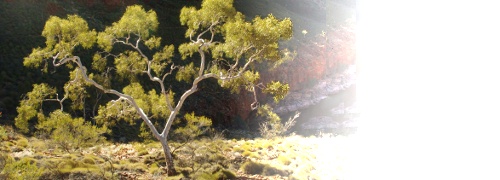Once the change to cold temperatures is perceived and the signal transduced to the nucleus, there follows a substantial reprogramming of the transcriptome, proteome and metabolome of the plant cell (i.e. cold acclimation). The cold acclimation response is best understood in herbaceous annuals such as Arabidopsis thaliana where members of the C-repeat binding factor (CBF or DREB1) family of transcriptional activators, which bind the cis-element known as the C-repeat (CRT)/dehydration-responsive element (DRE), have been shown to control the transcription of a suite of genes that play important roles in the development of freezing tolerance. Subsequent to their discovery in Arabidopsis, many CBF homologues have been found in both monocots and dicots, including perennial species such as aspen, birch and Eucalyptus. The CBF/DREB transcription factors are inducible by stress events but are not normally expressed under non-stress conditions. The plants response to stress therefore requires that there are components within the signal transduction pathway that are constitutively present but only active following the perception of the stress signal. For plant cold responses, a MYC-type bHLH (basic Helix-Loop-Helix) transcription factor, ICE1 (inducer of CBF expression 1), serves as an upstream activator of CBF expression. Transcriptional profiling of the ice1 mutant showed impaired expression of 40% of cold-regulated genes, suggesting ICE1 is one of the main regulators in the cold stress response, but also that it is not the only regulator. ICE1 is constitutively localized to the nucleus and induces CBF expression in a cold-dependent fashion (Figure 14.22). The ability of ICE1 to activate gene transcription in response to cold may be dependent on protein phosphorylation, making ICE1 a likely target of the MAPK cascades activated by the transient increase in [Ca2+]cyt, although the signalling components responsible for this activation are yet to be discovered.
The accumulation of CBF transcripts and the activity of the CRT regulatory motif in Arabidopsis is also modulated by the presence and quality of light during cold stress, and it also appears to be mediated by the circadian gate; with extent to which CBF transcripts accumulate in response to low temperatures being dependent on the time of day plants are exposed to low temperatures. Temperatures are typically at their lowest point in the diurnal cycle at night, and the ability to anticipate this day-night rhythm may give plants the ability to anticipate night frosts and thus confer an adaptive advantage. Entrainment of the circadian clock has been shown to be affected by temperature as well as by light and it appeared that this entrainment might be linked to the regulation of the cold stress response. Plants in temperate regions are also able to anticipate the onset of winter by detecting the shortening photoperiod. This light signalling, or measurement of the critical day-length, is mediated by the phytochromes and it is not surprising that sensing and signalling mechanisms controlling developmental processes such as bud set, seasonal senescence, growth cessation and dormancy overlap with cold acclimation. This potential for overlap is consistent with the observation that cold acclimation can be modified by the red and far-red light (R/FR) ratio. A decrease in R/FR ratio at the end of the day promotes cold acclimation, including increasing the expression of CBF genes; conversely, exposure to red pulses of light can undo this effect and a high R/FR reduces the accumulation of CBF-regulated gene expression. Finally, it is clear that there are ICE/CBF-independent pathways that participate in cold acclimation (e.g. expressions of ZAT, HOS and ESK); however, evidence pointing to the identity of the components in these pathways is scarce. Furthermore, in field or natural conditions it is likely that the transcriptomic, proteomic and metabolomic changes in response to alterations in the plants thermal regime will be more complex than those revealed by controlled laboratory experiments. Responses to additional stressors such as light and drought will overlap and will introduce different signalling pathways, particularly those involving ABA, but also brassinosteriods and jasmonic acid. As result, constructing a spatiotemporal network linking these different components in order to understand how these factors come together to limiting plant growth, productivity and distribution, is going to be an enormous challenge.
